Now that we’ve had the opportunity to use them in clinical practice, what place do these drugs have in our armamentarium? Are these drugs living up to their expected potential? Are providers incorporating them into their daily practice?
We went to some leaders in eye care to help answer these questions.
New Glaucoma Drops
• Simbrinza (brinzolamide/brimonidine tartrate 1%/0.2%, Alcon) is the first beta blocker-free, fixed-combination suspension indicated for the reduction of elevated intraocular pressure in patients with primary open-angle glaucoma or ocular hypertension.
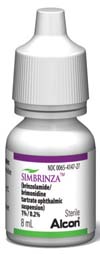 In Phase III studies, after six months of treatment, Simbrinza showed it lowered IOP by a mean of 1mm Hg to 3mm Hg more than the administration of either brimonidine tartate 0.2% or brinzolamide 1.0% individually, and a 21% to 35% sustained reduction in baseline IOP.1,2
In Phase III studies, after six months of treatment, Simbrinza showed it lowered IOP by a mean of 1mm Hg to 3mm Hg more than the administration of either brimonidine tartate 0.2% or brinzolamide 1.0% individually, and a 21% to 35% sustained reduction in baseline IOP.1,2
Although data showing two drugs combined is more effective than either drug administered individually is not exactly groundbreaking, there does still appear to be a useful therapeutic application. The general consensus among those consulted is to use Simbrinza not as first-line therapy but as adjunct therapy, especially for those patients in whom beta blockers are contraindicated and/or have crossed the threshold into multiple medications. The main reason cited was to simplify the instillation regimen: one bottle of Simbrinza TID vs. two bottles of brimonidine tartrate 0.2% and brinzolamide 1.0%. Simbrinza is an expensive combination of two very inexpensive generic drug classes, so keep this in mind if cost is more of a concern than convenience.
Remember that Simbrinza has not yet been studied in patients with kidney disease, so use it with caution as you would use each of the component medications separately. Paul Ajamian, OD, of Atlanta, says, “I have found a nice niche for patients who cannot use a beta blocker for pulmonary or heart reasons. Brinzolamide and brimonidine in one bottle works nicely, and with the Alcon Openings Patient Support Program, you may be able to save your patients some money. It is showing up on more and more formularies as well.”
Paul Karpecki, OD, of Lexington, Ky., agrees, stating that it is surprising how many patients with glaucoma also have pulmonary or heart disease, so the option of a non-beta blocker combination agent seems to fill that role. “I’ve found that in patients with breathing problems, it is a better additional medication to prostaglandin analogs for lowering IOP,” he says. “Patients don’t tend to tolerate more than two bottles total, so I’ve found myself going to combination agents much more often when needing additional IOP reduction.”
• Zioptan (tafluprost 0.0015%, Merck) is the first preservative-free prostaglandin analog (PGA) indicated to decrease IOP in patients with primary open-angle glaucoma or ocular hypertension. In a randomized clinical trial with 618 patients completing the study, preservative-free tafluprost lowered IOP as effectively as preservative-free timolol over a three-month period.3 According to clinical studies, preservative-free tafluprost has shown to be just as effective as other prostaglandins in reducing intraocular pressure in patients with open-angle glaucoma or ocular hypertension.11
 But besides being preservative-free, there is not much else that separates Zioptan from the other prostaglandin analogs. In Merck’s clinical trials, initial IOPs in the range of 23mm Hg to 26mm Hg were lowered 5mm Hg to 8mm Hg in six-month intervals. Furthermore, it is claimed Zioptan starts reducing IOP approximately two hours after instillation, with the maximum effect achieved in approximately 12 hours.3
But besides being preservative-free, there is not much else that separates Zioptan from the other prostaglandin analogs. In Merck’s clinical trials, initial IOPs in the range of 23mm Hg to 26mm Hg were lowered 5mm Hg to 8mm Hg in six-month intervals. Furthermore, it is claimed Zioptan starts reducing IOP approximately two hours after instillation, with the maximum effect achieved in approximately 12 hours.3
Cursory polling of the field indicates there is limited use of this drug. The most frequently stated reason for this is the availability of generic latanoprost 0.05%. That is, when deciding whether to start a patient on a prostaglandin analog, the generic formulation was considered first in efforts to ease the financial burden on patients.
Dr. Ajamian raises a good point when discussing the cost of Zioptan: “[It is] a great PGA, and you can get two days (at least four drops) out of every vial, which cuts the cost in half. The discount cards that Merck used to provide made this a $49 drop divided by two because a one-month supply will last two months, which means it’s a preservative-free PGA option for 25 bucks a month.”
Dr. Karpecki adds, “Having a preservative-free glaucoma medication has value, especially if patients are on more than one glaucoma medication. There is a significant level of ocular surface disease in glaucoma patients, and preservative-free medications can help those patients in comfort and sometimes even visual improvement.”
New Anti-Inflammatories
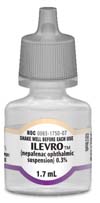 • Ilevro (nepafenac 0.3%, Alcon) is a suspension and a nonsteroidal anti-inflammatory prodrug indicated for the treatment of pain and inflammation associated with cataract surgery. It is dosed once daily, because its concentration was increased from 0.1% (as Nevanac) to 0.3%. Investigational studies showed patients treated with Ilevro were less likely to have ocular pain and measurable signs of inflammation (cells and flare) at the end of treatment than those treated with its vehicle.4
• Ilevro (nepafenac 0.3%, Alcon) is a suspension and a nonsteroidal anti-inflammatory prodrug indicated for the treatment of pain and inflammation associated with cataract surgery. It is dosed once daily, because its concentration was increased from 0.1% (as Nevanac) to 0.3%. Investigational studies showed patients treated with Ilevro were less likely to have ocular pain and measurable signs of inflammation (cells and flare) at the end of treatment than those treated with its vehicle.4
“I have found Ilevro to be effective in my clinical experience,” Dr. Karpecki says. “The particle size in Ilevro is 40% smaller than in Nevanac, which I believe allows for greater penetration, and the once-a-day dosing certainly helps with compliance. Ilevro also has excellent third-party insurance coverage.”
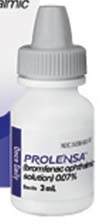 • Prolensa (bromfenac sodium 0.07%, Bausch + Lomb) is a topical, nonsteroidal anti-inflammatory drug (NSAID) indicated for treatment of postoperative inflammation and reduction of ocular pain in patients who have undergone cataract surgery. In two Phase III randomized, double-masked, placebo-controlled, multicenter clinical trials, 440 eyes were studied—222 in the bromfenac group and 218 in the placebo group. In this study, it was found that bromfenac 0.07% dosed once daily was clinically safe and effective compared with the placebo treatment for ocular inflammation and pain in subjects who had undergone cataract surgery. The study also showed bromfenac 0.07% achieved complete clearance of ocular inflammation by day 15. A statistically significantly higher proportion of subjects in the bromfenac 0.07% group were pain free at all study visits compared with those in the placebo group.5
• Prolensa (bromfenac sodium 0.07%, Bausch + Lomb) is a topical, nonsteroidal anti-inflammatory drug (NSAID) indicated for treatment of postoperative inflammation and reduction of ocular pain in patients who have undergone cataract surgery. In two Phase III randomized, double-masked, placebo-controlled, multicenter clinical trials, 440 eyes were studied—222 in the bromfenac group and 218 in the placebo group. In this study, it was found that bromfenac 0.07% dosed once daily was clinically safe and effective compared with the placebo treatment for ocular inflammation and pain in subjects who had undergone cataract surgery. The study also showed bromfenac 0.07% achieved complete clearance of ocular inflammation by day 15. A statistically significantly higher proportion of subjects in the bromfenac 0.07% group were pain free at all study visits compared with those in the placebo group.5
Dr. Ajamian reports good results with Prolensa and says, “We use it on all our pre- and post-op cataract patients.”
Dr. Karpecki adds that his clinic also has seen great success in patients using Prolensa and notes that the drop has been very comfortable for patients, easy to use given its QD dosing, and doesn’t require shaking. “Being a brominated molecule seems to help with corneal penetration, given the lower concentration of medication compared to Bromday.”
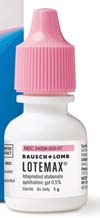 • Lotemax Gel/Lotemax Ointment (loteprednol etabonate 0.5%, Bausch + Lomb) is an ester-based corticosteroid indicated for the treatment of postoperative inflammation and pain following ocular surgery. Because the gel and ointment forms are non-settling, a uniform dose of loteprednol etabonate (LE) is delivered without the need to vigorously shake the product. In a study using the integrated analysis of data from two identical, prospective, multicenter, randomized, double-masked, parallel-group, vehicle-controlled trials, 813 patients (409 LE gel 0.5% and 404 vehicle) were studied. The results showed that 30.8% of patients given LE gel 0.5% vs. 15.1% of patients taking the vehicle had complete resolution of anterior chamber cells, while 74.3% on LE gel vs. 43.8% taking the vehicle had grade 0 pain postoperatively at day eight.8
• Lotemax Gel/Lotemax Ointment (loteprednol etabonate 0.5%, Bausch + Lomb) is an ester-based corticosteroid indicated for the treatment of postoperative inflammation and pain following ocular surgery. Because the gel and ointment forms are non-settling, a uniform dose of loteprednol etabonate (LE) is delivered without the need to vigorously shake the product. In a study using the integrated analysis of data from two identical, prospective, multicenter, randomized, double-masked, parallel-group, vehicle-controlled trials, 813 patients (409 LE gel 0.5% and 404 vehicle) were studied. The results showed that 30.8% of patients given LE gel 0.5% vs. 15.1% of patients taking the vehicle had complete resolution of anterior chamber cells, while 74.3% on LE gel vs. 43.8% taking the vehicle had grade 0 pain postoperatively at day eight.8
Jackson Lau, OD, of Beverly Hills, Calif., says, “It’s great; less dosing, longer contact time, hence better efficacy for my patients.” His one concern is the cost; even with the manufacturer’s rebate, he states it is still expensive and he may end up switching them to prednisolone.
Dr. Ajamian agrees that Lotemax ointment is very expensive, but finds it worthwhile for his uveitis patients to use for overnight coverage. “Since the arrival of LE ointment, no longer do practitioners have to use TobraDex ointment [tobramycin/dexamethasone, Alcon] to get the overnight usage of a steroid,” he says. Remember, LE gel (like all topical steroids) is contraindicated in most viral, mycobacterial and fungal infections of the cornea and conjunctiva.
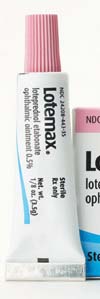 Dr. Karpecki also prefers the Lotemax ointment for overnight coverage in uveitis patients and has seen significant clinical improvement in patients with iritis since implementing an overnight steroid ointment regimen. He says he has not seen that many issues with cost, except in patients without insurance, as Lotemax gel seems to have relatively good insurance coverage. The attribute that he has found to be most beneficial in Lotemax gel is the uniform dosing and, unlike suspensions, there is no need for shaking. “So, you can be confident the patient is getting the proper amount of medication with each drop and throughout the course of treatment,” he says.
Dr. Karpecki also prefers the Lotemax ointment for overnight coverage in uveitis patients and has seen significant clinical improvement in patients with iritis since implementing an overnight steroid ointment regimen. He says he has not seen that many issues with cost, except in patients without insurance, as Lotemax gel seems to have relatively good insurance coverage. The attribute that he has found to be most beneficial in Lotemax gel is the uniform dosing and, unlike suspensions, there is no need for shaking. “So, you can be confident the patient is getting the proper amount of medication with each drop and throughout the course of treatment,” he says.
New Anti-Allergy Drugs
• Bepreve (bepotastine besilate 1.5%, Bausch + Lomb) is a topical, mast cell stabilizer and a histamine H1 receptor antagonist that is approved to treat itching associated with allergic conjunctivitis in patients two years of age and older. In a randomized clinical trial, this drug significantly reduced instantaneous and reflective ocular itching scores from baseline compared with placebo over the two-week study period.6
Dr. Lau, a pediatric optometrist, says, “I personally don’t think it works as well as other anti-allergy topical medications, but it could be the side effect of the metallic taste that makes me more reluctant to use that drop.”
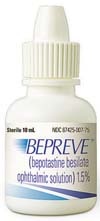
Dr. Karpecki disagrees. In his state of Kentucky, where allergy rates are some of the highest in the country, he has found this medication to work for all levels of allergic conjunctivitis, including severe presentations. He has also found great benefit from the additional resolution of non-ophthalmic symptoms, such as rhinitis, nasal congestion and itchy palate in patients using Bepreve.
In another study comparing patient-perceived relief of ocular itch, nasal symptoms and eye drop comfort in a small cohort of 30 patients with allergic conjunctivitis, patients were either treated with bepotastine besilate 1.5% twice daily or a once-daily allergy medication. Results showed 63.3% of patients preferred bepotastine besilate 1.5% for all-day relief of ocular itching and 66.7% preferred it for all-day relief of itchy/runny nose.7 In terms of comfort, there was no significant difference in the number of patients preferring one treatment over the other.
Dr. Ajamian agrees this drop works great: “This is my new go-to allergy drop. It helps a lot of people with itchy eyes and sinus problems as well.”
• Lastacaft (alcaftadine 0.25%, Allergan) is an H1 histamine receptor antagonist and a mast cell stabilizer indicated once daily for the prevention of itching associated with allergic conjunctivitis. It has also been shown to decrease chemotaxis and inhibition of eosinophilic activation.
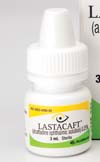
Clinical trials employed the conjunctival allergen challenge (CAC) model. The CAC doses known ocular allergy sufferers with the study drop and then, after a set period of time (e.g., 15 minutes or 16 hours), the eye is exposed to the allergen again (dust, cedar, pollen, animal dander, etc.) and the response is measured. In the first study, itching was measured three minutes after exposure to the allergen; eyes treated with Lastacaft had significantly less itching than those treated with the vehicle. Statistical improvement was noted at 15 minutes (early effect) and at 16 hours after dosing with Lastacaft.12
Because of the clinical efficacy 16 hours after the drop was instilled, the indicated dosing is once a day. The drug is a pregnancy category B product and is approved in patients two years old and above.
Many providers who were asked to share their thoughts on anti-allergy drops explained that these drugs are expensive and usually not covered by their patient’s insurance panels. Heidi Kopp, OD, who practices in Faribault, Minn., reiterated this by explaining, “Cost is a major issue with most of my patients and many insurance plans do not cover name brands. So it’s difficult for me to even try newer drugs when there are less expensive alternatives.”
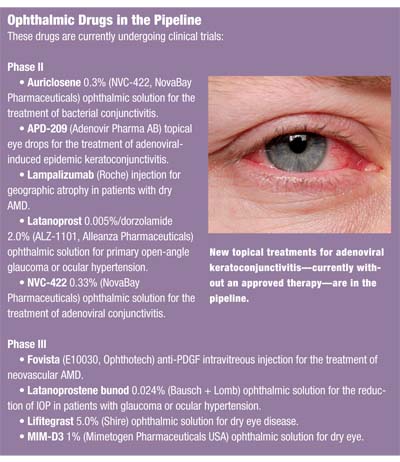 So, although these new drugs are exciting and great to have added to the arsenal of ophthalmic topical drugs, there may be some economical limits to them. Dr. Ajamian states, “All the new drops have a role. However, one has to be conscious of price and the sticker shock that patients may be faced with when they visit the pharmacy.”
So, although these new drugs are exciting and great to have added to the arsenal of ophthalmic topical drugs, there may be some economical limits to them. Dr. Ajamian states, “All the new drops have a role. However, one has to be conscious of price and the sticker shock that patients may be faced with when they visit the pharmacy.”
Dr. Karpecki says that many insurance companies will only cover OTC allergy products, making this class of medications expensive even for patients with insurance coverage. He has found that Alrex (loteprednol etabonate 0.2%, Bausch + Lomb) ends up being the substitute because it is covered. He also has some patients use OTC ketotifen medications, such as Alaway (Bausch + Lomb), Zaditor (Alcon) or TheraTears Eye Itch (Advanced Vision Research), in addition to the Alrex when cost is an issue.
As eye care providers, we are fortunate to have a wide arsenal of ophthalmic drugs for managing and treating ocular diseases and caring for our patients. Overall, these recent drugs add something new to our armamentarium, and have largely lived up to their promise since their approval.
Dr. Rittenbach and Dr. Pruitt practice at the Minneapolis Veteran Affairs Medical Center in Minnesota.
1. Whitson JT, Realini T, Nguyen QH, et al. Six-month results from a Phase III randomized trial of fixed-combination brinzolamide 1% + brimonidine 0.2% versus brinzolamide or brimonidine monotherapy in glaucoma or ocular hypertension. Clin Ophthalmol. 2013;7:1053-60.
2. Nguyen QH, McMenemy MG, Realini T. Phase 3 randomized 3-month trial with an ongoing 3-month safety extension of fixed-combination Brinzolamide 1%/Brimonidine 0.2%. J Ocul Pharmacol Ther. 2013 Apr;29(3) 290-7.
3. Chabi A, Varma R, Tsai JC, et al. Randomized clinical trial of the efficacy and safety of preservative-free tafluprost and timolol in patients with open-angle glaucoma or ocular hypertension. Am J Ophthalmol. 2012 Jun;153(6):1187-96.
4. Clinicaltrials.gov. Nepafenac 0.3% Two Study. NLM Identifier: NCT01318499. Available at: http://clinicaltrials.gov/ct2/show/NCT01318499. Accessed November 6, 2013.
5. Walters TR, Goldberg DF, Peace JH, Gow JA; Bromfenac Ophthalmic Solution 0.07% Once Daily Study Group. Bromfenac ophthalmic solution 0.07% dosed once daily for cataract surgery: results of 2 randomized controlled trials. Ophthalmology. 2014 Jan;121(1):25-33.
6. Carr WW, Nayak AS, Ratner PH, et al; Bepotastine Besilate Ophthalmic Solution 1.5% (Bepreve) Study Group. Efficacy of bepotastine besilate ophthalmic solution 1.5% for seasonal allergic conjunctivitis: a randomized, placebo-controlled, natural exposure, clinical trial. Allergy Asthma Proc. 2013 May-Jun;34(3):247-54.
7. McCabe CF, McCabe SE. Comparative efficacy of bepotastine besilate 1.5% ophthalmic solution versus olopatadine hydrochloride 0.2% ophthalmic solution evaluated by patient preference. Clin Ophthalmol. 2012;6:1731-8.
8. Rajpal RK, Fong R, Comstock TL. Loteprednol etabonate ophthalmic gel 0.5% following cataract surgery: integrated analysis of two clinical studies. Adv Ther. 2013 Oct;30(10):907-23.
9. Stalmans P, Benz MS, Gandorfer A, et al; MIVI-TRUST Study Group. Enzymatic vitreolysis with ocriplasmin for vitreomacular traction and macular holes. N Engl J Med. 2012 Aug 16;367(7):606-15.
10. Kim BT, Schwartz SG, Smiddy WE, et al. Initial outcomes following intravitreal ocriplasmin for treatment of symptomatic vitreomacular adhesion. Ophthalmic Surg Lasers Imaging Retina. 2013 Jul-Aug;44(4):334-43.
11. Aihara M. Clinical appraisal of tafluprost in the reduction of elevated intraocular pressure (IOP) in open-angle glaucoma and ocular hypertension. Clin Ophthalmol. 2010 Mar 24;4:163-70.
12. Torkildsen G, Shedden A. The safety and efficacy of alcaftadine 0.25% ophthalmic solution for the prevention of itching associated with allergic conjunctivitis. Curr Med Res Opin. 2011 Mar;27(3):623-31.

